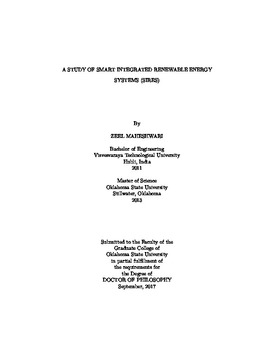| dc.contributor.advisor | Ramakumar, R. | |
| dc.contributor.author | Maheshwari, Zeel | |
| dc.date.accessioned | 2018-06-18T16:02:21Z | |
| dc.date.available | 2018-06-18T16:02:21Z | |
| dc.date.issued | 2017-09 | |
| dc.identifier.uri | https://hdl.handle.net/11244/300062 | |
| dc.description.abstract | Energy availability is a severe problem in majority of the remote rural areas of the world. Development of energy-resources-poor rural areas has been discussed by many in the past. Rural electrification was the first major effort undertaken globally. Harnessing locally available renewable energy resources as an environmentally friendly option is gaining momentum. Smart Integrated Renewable Energy Systems (SIRES) offer a resilient and economic path to "energize" the area and reach this goal. The hallmark of the proposed SIRES is the smart utilization of several renewable resources in an integrated fashion and matching of resources and needs a priori with the ultimate goal of "energization", not just "electrification". Historical background leading to this approach is succinctly presented along with a comprehensive schematic diagram. Modeling of various components and their collective use in optimizing SIRES with the aid of genetic algorithm are presented using a typical hypothetical example. SIRES is also compared with various approaches for rural development based on Annualized Cost of System (ACS) and installation costs. Economic, social and environmental aspects of viability of SIRES for sustainable development are reviewed. This study also discusses intelligent control of SIRES using neural networks and fuzzy logic. Simulation results show that the operation of SIRES can be kept within defined constraints for critical storage devices. Technical effectiveness of SIRES is assessed based on a novel index, Need Fulfillment Probability (NFP). NFP is estimated for four different weather conditions where insolation and wind resources are varied and compared to microgrid for the considered weather conditions. Hierarchical Markov modeling approach is applied to determine the availability of SIRES characterized by system component failure and repair rates. SIRES promote socio-economic development and improve the living environment by fulfilling the fundamental energy requirements with the help of low cost renewable technologies and intelligent energy management systems. Implementation of SIRES will lead to overall sustainable development of rural communities. | |
| dc.format | application/pdf | |
| dc.language | en_US | |
| dc.rights | Copyright is held by the author who has granted the Oklahoma State University Library the non-exclusive right to share this material in its institutional repository. Contact Digital Library Services at lib-dls@okstate.edu or 405-744-9161 for the permission policy on the use, reproduction or distribution of this material. | |
| dc.title | Study of Smart Integrated Renewable Energy Systems (SIRES) | |
| dc.contributor.committeeMember | Hagan, Martin T. | |
| dc.contributor.committeeMember | Cheng, Qi | |
| dc.contributor.committeeMember | Rhinehart, R. Russell | |
| osu.filename | Maheshwari_okstate_0664D_15428.pdf | |
| osu.accesstype | Open Access | |
| dc.type.genre | Dissertation | |
| dc.type.material | Text | |
| thesis.degree.discipline | Electrical Engineering | |
| thesis.degree.grantor | Oklahoma State University | |
